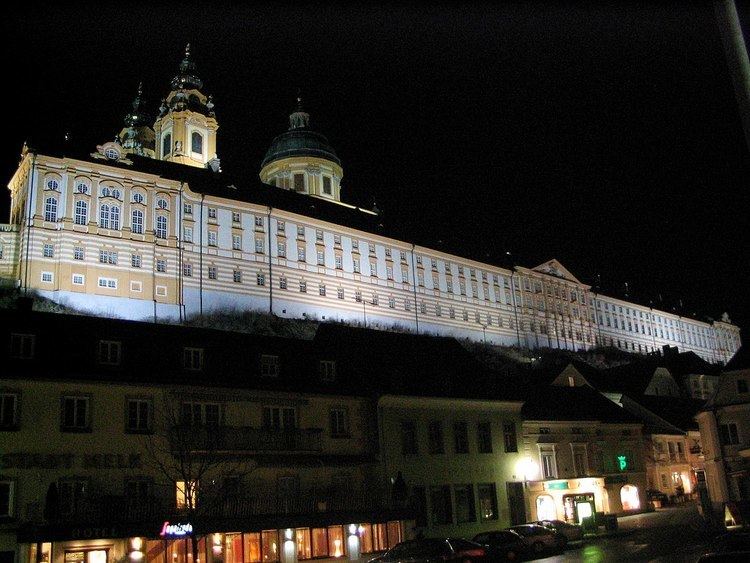Religious affiliation(s) Christianity Status open School code 315016 Number of students 909 (2011–2012) | Denomination Roman Catholic Established before 1140 Phone +43 2752 555411 Motto Discimus vitam | |
 | ||
Similar Melk Abbey, Höhere Technische Bundesle, Bundesg und Bundesre, BG / BRG St Pölten | ||
Maturaball des stiftsgymnasium melk 7 09 2013 er ffnung tanzschule hanickel
Stiftsgymnasium Melk (German: Melk Abbey's gymnasium) is a Roman Catholic Benedictine-run gymnasium located in Melk, Austria. The gymnasium is located within and run by the well-known monastery Melk Abbey. Founded in the 12th century as a monastic school, it is also the oldest continuously operating school in present-day Austria.
Contents
- Maturaball des stiftsgymnasium melk 7 09 2013 er ffnung tanzschule hanickel
- Stiftsgymnasium melk
- Medieval monastic school
- Modern school 17071938
- Since 1945
- Notable alumni
- Notable teachers
- References
Stiftsgymnasium melk
Medieval monastic school
The earliest documents proving the existence of a medieval monastic school at Melk Abbey are a parish register and some parchment scraps dating back to about 1140 and 1160 respectively. It is assumed that it was founded sometime in the first half of the 12th century, but it may already hung over from the monastery's establishment in 1089. In the 15th century, alongside the Melk Reform strongly influencing Austrian and Bavarian Benedictine religious life, the school flourished and gained reputation. So, for instance, in 1446 a monk called Simon wrote an education book for six-year-old King Ladislaus the Posthumous of Hungary. However, starting from around 1530 and mainly caused by the onset of the Protestant Reformation in the Habsburg Empire, the abbey suffered from a dramatic lack of personnel, and so did the school. In 1566, there were only six clergymen.
This crisis went on till the end of the 16th century, when in the wake of the Counter-Reformation more and more students from South German Jesuit Colleges attended the school. Those students, amongst them also poeta laureatus Laurentius Flenheintius, brought along very good education and raised the school's standard again. Therefore, in 1596 it was reshaped along the lines of a Jesuit College. Through this reform only the four lower classes remained in Melk, to finish school students had to do two further sessions in Vienna. In 1707, Abbot Berthold Dietmayr converted the school into a full, contemporary gymnasium.
Modern school 1707–1938
Starting from the beginning of the 1781/82 session, the Stiftsgymnasium due to Empress Maria Theresa’s education policies was referred to as gymnasium publicum, a type of school that was "partially open to the public". In 1787, Joseph II relocated it to Sankt Pölten since he had made the city a diocesan town three years before and thus wanted it to have an "appropriate" school, too. The school then did not return to Melk until 1804. In 1811, Abbot Anton Reyberger established the school’s boarding home, which was opened November 7. Moreover, a preparatory class (praeparanda) was introduced to facilitate pupils’ transition from their small village schools to gymnasium, it persisted till 1927. In 1850, the number of classes was raised to eight and hence in 1851 the first Matura exams could take place in Melk. At that time, the school’s scientific collections were constituted and exceptionally promoted.
According to the school’s annual report of 1861 in that year there was a total enrollment of 208, including 51 boarders. As from 1873 there were secular teachers in minors, from 1879/80 those taught chief subjects as well. In 1877/78 the school was structurally extended, so, for instance, a new physics room and a new refectory were built. In 1905, the Episcopal Seminary of Melk was unclosed, where till its closure in 2006 pupils of Stiftsgymnasium were housed. In order to distinguish them from the students who lived in the boarding home situated in the monastery (germ. Konvikt) and hence were called Konviktisten those seminary pupils were known as Seminaristen.
After Austria’s incorporation into the German Reich (Anschluss) Principal Fr. Wilhelm Schier by March 13, 1938, was deposed and replaced by Nazi-affiliated Fr. Coelestin Schoiko. In late 1938 the school was closed down completely and later converted into a National Political Institute of Education (commonly known as Napola).
Since 1945
After some reconstruction and clearing work was done it was possible to restore school life as early as by September 1945. In 1966, an annual student exchange program to Saint John's Preparatory School in Collegeville, Minnesota (also operated by a Benedictine abbey, Saint John's) was established, persisting until today. With appreciably declining enrollment numbers, Stiftsgymnasium was declared co-educational (admitting girls as well) by the session of 1967/68, and a modern-language branch ("neusprachlicher Zweig", focusing on French), as opposed to the "classical" branch ("humanistischer" or "altsprachlicher Zweig", focused on the teaching of Latin and Ancient Greek), was adopted. In 1972, Abbot Reginald Zupancic appointed Ernst Wegscheider principal, thereby the office was held by a layman for the very first time. Since 1973 all teachers at Stiftsgymnasium are publicly funded, posing a markedly financial relief for the school.
Notable alumni
The Stiftsgymnasium's alumni as well as other former students are called Altmelkers. There is an alumni association named Verein der Altmelker und Freunde (Association of Altmelkers and Friends), which furthermore awards scholarships to current students.
